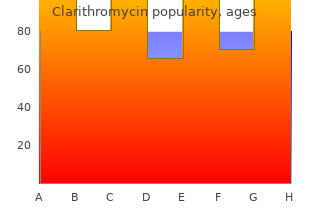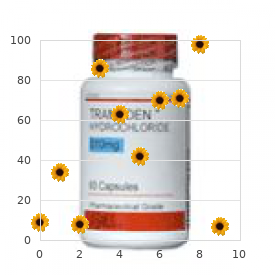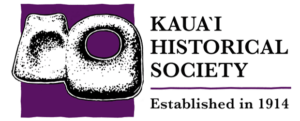Clarithromycin
"Effective clarithromycin 500 mg, gastritis diet livestrong".
By: H. Carlos, M.A., Ph.D.
Program Director, State University of New York Downstate Medical Center College of Medicine
Instruct the patient to gastritis diet ����������� buy 500 mg clarithromycin seek instant medical attention within the event of priapism [Warnings and Precautions (5 gastritis attack quality 500mg clarithromycin. Heat Exposure and Dehydration Counsel sufferers on the importance of avoiding overheating and dehydration [see Warnings and Precautions (5 gastritis diet ��������� safe 500 mg clarithromycin. Keep a list of them to gastritis diet ������ best 500mg clarithromycin show to your healthcare supplier or pharmacist if you get a new medication. Call your healthcare supplier immediately should you turn into severely ill and have any of those signs: ◦ excessive fever ◦ severe muscle stiffness ◦ confusion ◦ lack of consciousness ◦ modifications in your breathing, heartbeat and blood stress. Metabolic modifications may embody excessive blood sugar (hyperglycemia), diabetes mellitus and modifications within the fats ranges in your blood (dyslipidemia), and weight gain. Call your healthcare supplier or go to your nearest emergency room immediately in case you have an erection that lasts more than four hours. Medicines are sometimes prescribed for functions aside from these listed in a Patient Information leafet. Active ingredient: paliperidone palmitate Inactive components: polysorbate 20, polyethylene glycol 4000, citric acid monohydrate, sodium dihydrogen phosphate monohydrate, sodium hydroxide, and water for injection Revised: 07/2018 Manufactured by: Janssen Pharmaceutica N. Funding info and disclosures deemed related by the authors, if any, are offered at the end of the article. Definition and standardization of scientific criteria vs other pathologic diagnoses. Previous scientific criteria has been achieved for other neurodegenera excluded “early dementia” to enhance diagnostic speci tive ailments. Invited worldwide specialists in behavioral neurology, wasprovidedbyMayoClinicRochester(22patients, neuropsychology, and motion problems met on October K. Josephs, personal communication, 2011), University 14–15, 2009, and based on individuals’ expertise and literature of Western Ontario (8 sufferers, A. Subsequently, a systematic literature search and later update utilizing versity of California San Francisco (20 sufferers, S. Dickson, personal com Search terms included “corticobasal,”“corticobasal degeneration,” munication, 2011). Information was entered right into a database including presentation predominated, manifesting with asym commonly reported options and people deemed related by the panel. Limb rigidity (eighty five%) the unique brain financial institution knowledge were abstracted quite than utilizing the less and bradykinesia (76%) were the most common motor comprehensive info from brain financial institution–associated publications. Although often characterized as severe, the character of Clinical options were recorded at 2 time parameters, at presenta limb rigidity was hardly ever described and should relate to tion and “ever” (through the illness course), variables for which the parkinsonism, dystonia, or gegenhalten/paratonia. Presentation was a imply of 18 Axial rigidity was reported in 27% at presentation 3. Because of this strategy, the denominator for mented through the illness course (table 1), representing calculating the frequency of any given scientific feature is less than a mixture of resting, postural and action, and undefined the entire variety of circumstances identified, reflecting the variety of circumstances tremors. Limb dystonia 18/91 (20) forty seven/123 (38) Apraxia is core to all previous diagnostic criteria Myoclonus 14/94 (15) 34/128 (27) (table e-1). The total variety of circumstances reviewed was 209, however is probably the most commonly described apraxia in not all knowledge had info on presenting signs. The timing of falls was opening,”13,15,sixteen,18,21,24 though the latter is usually a hardly ever described. Speech a abnormalities generally were described in fifty three% of circumstances the denominator represents the entire variety of circumstances where it was talked about whether or not or not the feature in query was current. Dickson, personal commu nication, 2011) and three sufferers received other diagnoses16 was recorded (table 2), however this info was pro vided in less than half of circumstances. Two pa lished patient had hallucinations, coincident with tients received no syndromic diagnosis. Sixty percent of com and the distinction in frequency between early and late piled circumstances had eye motion abnormalities. At scientific diagnoses underscores the problem in making onset, 33% confirmed such abnormalities (table 3). Table 3 Frequency of other options in available brain banks and research with ‡5 pathologically confirmed corticobasal degeneration casesa Age. Age at onset ranged Feature At presentation, n (%) During complete course, n (%) 15,sixteen,18,fifty one from 45 to seventy seven. Potential differentiating options are less restrictive however still emphasize shows consis described within the supplemental textual content however require validation tent with underlying tau pathology. Our results must be inter ogy (supplemental textual content), the presence of coincident preted with this limitation in mind. Does corticobasal McMonagle, Andrew Kertesz, Peachie Moore, Murray Grossman, Suzee E. Accuracy of the scientific their persistence as we study more about this difficult area. A quantitative examine of nigral degeneration with neuronal achromasia: a progressive the pathological lesions within the neocortex and hippocampus of dysfunction in late adult life. Cortical-basal ganglionic and pharmacological remedy in corticobasal degeneration. Cortical-basal gan and its relationship to progressive supranuclear palsy and glionic degeneration. Clas ical diagnosis of early-onset dementias: diagnostic accuracy sification of primary progressive aphasia and its variants. Alzheimer ologic analysis of frontotemporal and corticobasal degenera Dis Assoc Disord 2007;21:one hundred fifty five–163. A novel tau chological findings in clinically atypical post-mortem confirmed mutation (N296N) in familial dementia with swollen achro corticobasal degeneration and progressive supranuclear palsy. Neurology mutation within the progranulin gene causing familial cortico 2000;fifty five:1368–1375. Corticobasal syn and genetic correlates of frontotemporal lobar degeneration drome related to the A9D Progranulin mutation. Neurology motor examine in corticobasal degeneration and progressive 2010;75:1879–1887. Oculomotor func tions from the National Institute on Aging-Alzheimer’s tion in frontotemporal lobar degeneration, associated disor Association workgroups on diagnostic guidelines for Alz ders and Alzheimer’s illness. Furthermore, the data for the guide are largely derived from incidence and prevalence statistics whose accuracy will vary extensively for individual ailments and international locations. The list of medicine, infectious ailments and even nation names will vary with time. References the preliminary gadgets within the first section, Descriptive epidemiology, are outlined as follows: Agent Classification. Reservoir Any animal, arthropod, plant, soil or substance by which an infectious agent usually lives and multiplies, on which it depends primarily for survival, and where it reproduces itself in such a way that it may be transmitted to a susceptible host. Vector An arthropod or other residing provider which transports an infectious agent from an infected organism or reservoir to a susceptible individual or instant surroundings. The availability and high quality of literature regarding specific infectious ailments vary from nation to nation. As such, you could discover that many of the sections in this guide are limited to a general dialogue of the illness itself with no knowledge regarding Haiti. For example, such designations as Pneumonia bacterial and Urinary tract an infection embody numerous individual ailments. An anaerobic gram-optimistic bacillus Reservoir Human oral, fecal, vaginal flora Vector None Vehicle Endogenous Incubation Period Unknown Gram stain and bacteriological tradition utilizing strict anaerobic method. Alternatives: Doxycycline, ceftriaxone, Erythromycin Excision/drainage Ampicillin 50 mg/kg/day i. Typical Pediatric Therapy Penicillin G 100,000 models/kg/day X four to 6w; then Penicillin V 25,000 models/day X 6 to 12m. Excision/ drainage Mandibular osteomyelitis with fistulae (sulfur granules) within the setting of poor dental hygiene [oral Clinical Hints actinomycosis]; intrauterine device and pelvic abscesses [pelvic actinomycosis]; fever, right lower quadrant mass and fistulae [belly actinomycosis]. Pulmonary illness may prolong throughout fissures or pleura, and involve the mediastinum, pericardium (hardly ever endocardium) or contiguous bone. Adenoviridae, Adenovirus Enteric strains categorized in genus Mastadenovirus Reservoir Human Non-human primates Vector None Vehicle Droplet Water Incubation Period 4d 12d Diagnostic Tests Viral tradition/serology or antigen assay.

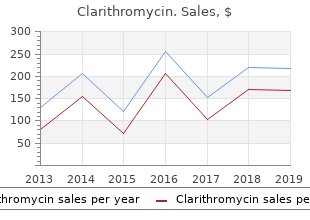
Arenaviridae: Lassa virus causes Lassa fever in West Africa gastritis diet �� safe 250mg clarithromycin, the place endemic transmission is related to gastritis weed cheap 250mg clarithromycin infected Mastomys rodents chronic gastritis biopsy clarithromycin 250 mg. Over 5 gastritis diet ���������� 250mg clarithromycin,000 deaths in West Africa are attributed to Lassa each year, with between 200,000 – 300,000 annual infections. Bolivian, Brazilian, and Venezuelan hemorrhagic fevers are attributable to the related Machupo, Guanarito, and Sabia viruses, respectively. Nosocomial transmission is probably potential with all Arenavirus infections but is incessantly a problem with Lassa fever. Lassa infection of well being-care workers has been attributed to parenteral exposures, contact with physique fluids, and aerosols generated by sufferers. These viruses are transmitted from their rodent reservoirs to people by way of inhalation of dusts contaminated with rodent excreta. It can also be unfold by contact with the physique fluids or slaughtered meat of infected animals and in well being-care settings. Hantaan 75 virus infection is also called Korean hemorrhagic fever or epidemic hemorrhagic fever. Severe illness also occurs in some Balkan states, together with Bosnia, Serbia, and Greece. Nephropathia epidemica is a milder illness that occurs in Scandinavia and other components of Europe and is attributable to a virus carried by bank voles (small rodents of the genus Microtus and related genera). The hantaviruses are transmitted to people via inhalation of dusts contaminated with rodent excreta. Filoviridae: Ebola hemorrhagic fever was first acknowledged in the western equatorial province of the Sudan and a nearby region of Zaire in 1976. In 1995 a single index case resulted in a big outbreak (316 instances) in Kikwit, Zaire. Subsequent epidemics have occurred in Gabon, Ivory Coast, Uganda, Republic of Congo, and Sudan. The Zaire and Sudan species of Ebola virus trigger severe illness with high mortality. A related virus (Ebola Reston) was isolated from monkeys imported into the United States from the Philippine Islands in 1989. While subclinical infections occurred amongst uncovered animal handlers, Ebola Reston has not been recognized as a human pathogen. Marburg epidemics have occurred on six events: 5 times in Africa, and as soon as in Europe. The first acknowledged outbreak occurred in Marburg, Germany and in Yugoslavia, amongst individuals uncovered to African inexperienced monkeys. Filoviruses may be unfold from human to human by direct contact with infected blood, secretions, organs, or semen. Ebola Reston apparently unfold from monkey to monkey and from monkeys to people by the respiratory route. Flaviviridae: Yellow fever and dengue are two mosquito-borne illnesses which have nice significance in the historical past of navy campaigns and navy medicine. Tick-borne flaviruses include the brokers of Kyasanur Forest illness in India, and Omsk hemorrhagic fever in Siberia. This 76 constellation of findings is troublesome to discern from any number of viral, bacterial or parasitic illnesses. A outstanding theory explaining this phenomenon is called “antibody-dependent enhancement. The reasons for variation amongst sufferers infected with the same virus are nonetheless unknown but probably stem from a complex system of virus-host interactions. Epidemiologic features may be useful, particularly the proportion of instances with delicate or average illness compared to the proportion with severe illness. A petechial or vesicular enanthem involving the palate and tonsillar pillars is sort of widespread, as is conjunctival injection and flushing of the upper torso and face. Patients incessantly have related neurologic illness, with initial hyporeflexia adopted by gait abnormalities and cerebellar dysfunction. Less than 10% of infections end in severe illness, but mortality in these sufferers can be as high as 25%. Hemorrhagic phenomena are relatively unusual, but sufferers incessantly have retrosternal chest ache, sore throat and proteinuria. Syndromes with features of encephalitis and/or meningitis are typically current, as are convalescent cerebellar syndromes. About 10% of sufferers develop retinitis with cotton-wool exudates in or across the macula. Only 1% develop hemorrhagic manifestations or severe hepatic illness, often occurring as a second febrile section after defervescence from an initial febrile section of 3 – 7 days. A small minority of sufferers develops encephalitis after the initial febrile illness. Disease onset is often abrupt and is related to fever, malaise, myalgia, headache and lassitude. Some characteristic features are flushing of the face and neck, conjunctival and pharyngeal injection, cutaneous and mucosal petechiae (occuring by day 4-5), and profound low back ache. Renal dysfunction is pathognomonic, incessantly progressing to oliguric renal failure. A subsequent diuretic section often accompanies convalescence, and fluid management may be a major problem. Onset is abrupt with fever, constitutional symptoms, nausea, vomiting, diarrhea, belly ache, lymphadenopathy, pharyngitis, conjuctival injection, jaundice and pancreatitis. A massive number of sufferers develop a maculopapular rash around day 5, but this may be troublesome to recognize in darkish-skinned individuals. Objective findings are unimpressive aside from the frequent look of relative bradycardia (Faget’s sign) and leukopenia. After a period of scientific improvement and defervescence (hours to days) some sufferers develop a second febrile section. This so known as period of intoxication is characterized by high fever, severe constitutional symptoms, obtundation, pores and skin and mucous membrane hemorrhages, severe hepatitis and profound jaundice. Liver related enzyme elevation occurs in a sample consistent with hepatocellular damage, and bilirubin may be fairly high. As severe illness progresses, renal failure consistent with hepatorenal syndrome may ensue. The first section is a febrile viral syndrome of varying severity, related to conjuctival suffusion, facial flushing, lymphadenopathy and splenomegaly. In its most 78 severe form, this syndrome may be accompanied by diffuse mucosal hemorrhaging and petechiae. Survivors may expertise problems of iritis, keratitis or neuropsychiatric abnormalities. Other illnesses in the differential diagnosis may include typhoid fever, nontyphoidal salmonellosis, leptospirosis, rickettsial infections, shigellosis, relapsing fever, fulminant hepatitis, and meningococcemia. Most sufferers have readily detectable viremia at presentation (exception: hantavirus infections). Diagnosis by virus replication and identification requires three to 10 days or longer. With the exception of dengue, specialised microbiological containment is required for safe dealing with of these viruses. The benefits of intravascular units and invasive hemodynamic monitoring should be carefully weighed against the significant danger of hemorrhage. Restlessness, confusion, myalgia, and hyperesthesia ought to be managed by conservative measures, together with the even handed use of sedatives and analgesics. Secondary infections may occur as with all affected person managed with invasive procedures and units. Red blood cells, platelets and clotting components ought to be changed, guided by scientific indicatation and coagulation studies. Intramuscular injections, aspirin, and other anticoagulant drugs ought to be prevented. Several trials have suggeste that ribavirin lowers both the morbidity and mortality of Lassa fever. Since the supply of intravenous ribavirin is small, oral ribavirin may be required in a mass-casualty situation. Oral ribavirin is licensed for the treatment of hepatitis C infection and is commercially available in the United States. Side effects of ribavirin include modest reversible hemolytic anemia and bone marrow suppression.
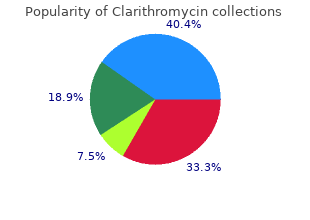
Rehabilitation Medicine prioritizes function as the objective of service delivery gastritis diet what can i eat 500 mg clarithromycin. The use of objective measure of function permits evaluation of this and subsequent audit of medical effectiveness of service delivery in adequate discharge planning and minimization of readmission risk gastritis juice diet 250mg clarithromycin. Criteria : Inclusion: All patient referral/ admission for inpatient rehabilitation care gastritis ulcer diet proven 500 mg clarithromycin. All inpatients for rehabilitation care with length of keep of lower than 5 working days of admission gastritis gaps diet order clarithromycin 250 mg. Type of indicator : Rate-primarily based outcome indicator Numerator : Number of inpatients with useful measure evaluation previous to cessation of inpatient rehabilitation Care Denominator : Total number of inpatients who ceased an inpatient rehabilitation Care in the course of the specified time period Formula : Numerator x one hundred % Denominator Standard : ≥ 90% Data Collection : 1. Soft tissue: muscle and muscular imbalance, tendon, ligament, joint, cartilage, meniscus, etc. Cases need early/ urgent consideration that need to be referred to the Emergency Department or given an earlier appointment date such as: i. Acute traumatic injury (fracture and/ or dislocation that require surgical fixation). Type of indicator : Rate-primarily based process indicator Numerator : Number of latest cases that were given appointment for first session inside (≤) four weeks at Sports Medicine Clinic Denominator : Total number of new cases referred to Sports Medicine Clinic Formula : Numerator x one hundred % Denominator Standard : ≥ 70% Data Collection : 1. Definition of Terms : Waiting time: Time of registration/ appointment (whichever is later) to the time the patient is first seen by the physician. Type of indicator : Rate-primarily based process indicator Numerator : Number of sufferers with ready time of ≤ 90 minutes to see the physician at Sports Medicine Clinic Denominator : Total number of sufferers seen at Sports Medicine Clinic in the course of the specified time period Formula : Numerator x one hundred % Denominator Standard : ≥ 70% Data Collection : 1. Remarks : Indicator four : Departmental Discipline : Sports Medicine Indicator : Percentage of inpatient rehabilitation sufferers referred for weight administration program seen inside 7 working days from date of referral Dimension of Quality : Effectiveness Rationale : Patients present process inpatient rehabilitation in the same hospital and located to have weight points may be referred to Sports Medicine as outpatients for weight administration program. Need to optimize inpatient rehabilitation and services, incorporating train prescription for weight administration with ongoing rehabilitation as well as acculturating train as an ongoing lifestyle after successful rehabilitation and discharge. Patients demonstrating unhealthy pattern of increasing physique weight (physique fats) throughout inpatient rehabilitation. Criteria : Inclusion: inpatient rehabilitation sufferers with weight points referred for weight administration program. Where: Data will be collected in Sports Medicine wards or wards that cater for the above condition. Remarks : Indicator 5 : Individual Discipline : Sports Medicine Indicator : Incidence of septic arthritis inside (≤) 2 weeks of intra or peri-articular injection Dimension of Quality : Safety Rationale : 1. Sports physicians might utilize the administration of intra or peri-articular injection as a part of remedy. Although rare, the process has been recognized as a risk issue for the development of septic arthritis. Septic arthritis presents an orthopaedic emergency that requires prompt recognition and early remedy to evade severe morbidity and mortality. Definition of Terms : Septic arthritis: Synovial joint an infection demonstrating the anticipated medical manifestations and supported analysis with laboratory exercise, especially positive synovial fluid tradition. Shoulder joint advanced (Glenohumeral joint, Acromioclavicular joint, Subacromial space). Clinical manifestation of septic arthritis with evidenced by positive synovial fluid tradition. Immunocompromised sufferers Type of indicator : Rate-primarily based outcome indicator Numerator : Number of sufferers with septic arthritis inside (≤) 2 weeks of intra or peri-articular injection Denominator : Total number of sufferers acquired intra or peri-articular injection Formula : Numerator x one hundred % Denominator Standard : < 1% Data Collection : 1. Where: Data will be collected in Sports Medicine Clinic/ Sports Medicine wards or wards that cater the above condition. The subjects have been instructed to carry out a managed, balanced landing and to hold the landing foot in place. The distance was measured in centimetres from the toe line on the push-off to the heel where the subject landed. How frequent: Yearly data collection (patient to be adopted up at a 12 months cohort). Knee scoring systems represent outcome measures which is used to measure medical change in sufferers over time. It allows for evaluation of the effectiveness of rehabilitation or any intervention when the knee scoring is repeated at a later interval. There are many knee scoring systems out there, certainly one of which is the Lysholm Knee Scoring Scale. Definition of Terms : Lysholm Knee Scoring Scale: It is principally used to consider patient signs and performance throughout actions of day by day residing and work. In case of interventions, it has been used to assess the effectiveness of knee arthroscopy, ligament reconstructions, meniscal repair, meniscectomy, microfracture, intra-articular hyaluronic acid injection and therapeutic train. It is an 8-item questionnaire scored on a 0-one hundred weighted scale measuring ache (25 points), instability (15 points), swelling (10 points), limp (5 points), stair-climbing (10 points), squatting (5 points) and use of assist (5 points). The evaluation of the patient progress will be made at appropriate intervals by re-administering the Lysholm Knee Scoring Scale at a later interval. Patients who have been already being adopted up at other centres and then referred for continued administration. Exclusion: Known diabetic sufferers who already on comply with up Type of indicator : Rate-primarily based outcome indicator Numerator : Number of sufferers ≥ 18 years previous screened for diabetes Denominator : Total number of new sufferers in a month Formula : Numerator x one hundred % Denominator Standard : ≥ 70% Data Collection : 1. Remarks : Indicator 9 : Individual Discipline : Sports Medicine Indicator : Percentage of sufferers with acute musculoskeletal injury seen inside (≤) 2 weeks after the first evaluation in clinic Dimension of Quality : Effectiveness Rationale : 1. Acute musculoskeletal accidents are associated with local inflammatory reactions which can mask its precise medical manifestation. Reviewing the patient inside 2 weeks and after applicable acute phase rehabilitation facilitates in reaching accurate analysis, avoiding pitfalls and applicable medical determination making. Definition of Terms : Acute musculoskeletal injury: Any musculoskeletal injury with acute onset inside 6 weeks previous to first encounter. Injury that has occurred more than 6 weeks before first encounter in sports medicine clinic. Type of indicator : Rate-primarily based outcome indicator Numerator : Number of sufferers with acute musculoskeletal accidents seen inside (≤) 2 weeks after the first evaluation in clinic Denominator : Total quantity sufferers with acute musculoskeletal accidents seen after the first evaluation in clinic Formula : Numerator x one hundred % Denominator Standard : > 70% Data Collection : 1. Utilization of donated blood may be totally optimized by making ready blood components from the collected entire blood. It is anticipated that requirement for plasma will improve as soon as the National Plasma Fractionation Program is carried out from 2016 onwards. It is a program to fractionate Malaysian plasma into plasma-derived merchandise for patient use. Definition of Terms : Blood components: Therapeutic components of blood (purple cell, white cell, platelets, plasma) that may be ready by centrifugation, filtration and freezing utilizing standard blood financial institution methodology. Blood transfusion is a complex process which includes several personnel within the blood banks and medical departments. Blood financial institution error: Any error occurring within the laboratory, from the time of the patient pattern is acquired until the blood and blood components are launched for transfusion. Who should confirm: All efficiency data have to be verified by Head of Department/ Head of Unit/ Hospital Director/ Hospital Transfusion Committee. Remarks : Indicator 3 : Departmental Discipline : Transfusion Medicine Indicator : Timeliness of blood provide for urgent cases inside (≤) 30 minutes Dimension of Quality : Customer centeredness Rationale : Timely blood provide is crucial for patient care in emergency situation and can help to reduce mortality and morbidity. Definition of Terms : Urgent cases: Cases that require blood immediately to save life. Blood provide will both be of secure O or group particular after emergency cross-matched process performed. Within (≤) 30 minutes: Time taken from the time pattern acquired at blood financial institution to the time first unit of blood launched from blood financial institution. All urgent blood request as specified by the attending clinician as acknowledged within the request type, informed by cellphone call by the clinician or staff from the ward. Cases that required complete antibody identification and provide of appropriate blood. Type of indicator : Rate-primarily based process indicator Numerator : Number of urgent cases where blood are supplied inside (≤) 30 minutes Denominator : Total number of urgent cases where blood is requested Formula : Numerator x one hundred % Denominator Standard : ≥ 90% Data Collection : 1. Where: Data will be collected in hospital’s blood financial institution / Transfusion Medicine Department/ Unit. Remarks : Indicator four : Individual Discipline : Transfusion Medicine Indicator : Percentage of newly diagnosed thalassaemia sufferers with new development of purple cell antibody/ ies (ranging from July, 2014) Dimension of Quality : Effectiveness Rationale : 1. All newly diagnosed sufferers with thalassaemia ranging from July, 2014 should be phenotyped for clinically important purple cell antigens at analysis or previous to the first transfusion 2. Definition of Terms : Thalassaemia sufferers: Patients who require repeated purple cell transfusions. New development of purple cell antibody/ ies: Development of purple cell alloimmunization due to publicity of foreign purple cell antigen within the transfused blood.
250mg clarithromycin. Diabetes treatment in hindi | मधुमेह का घरेलु इलाज.
